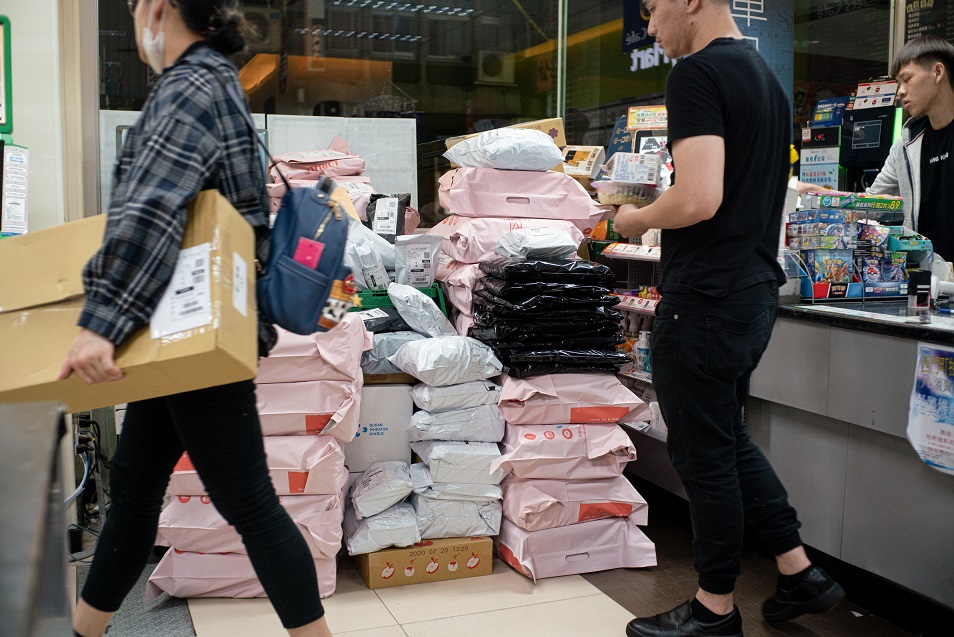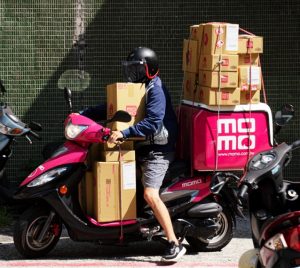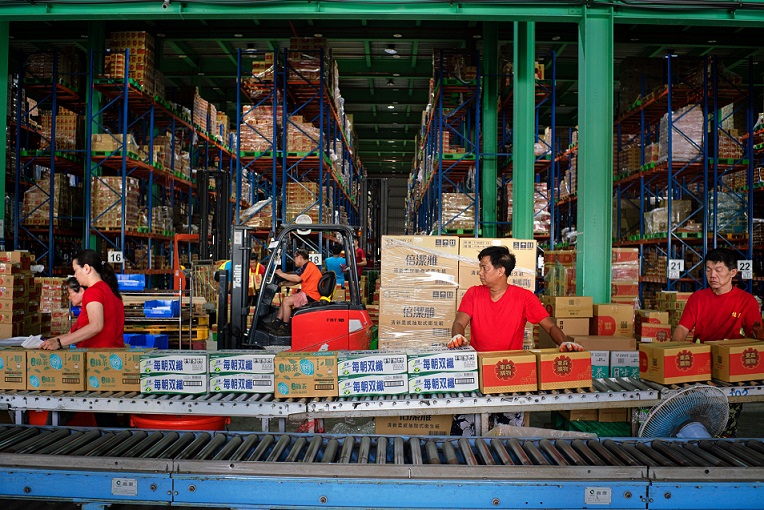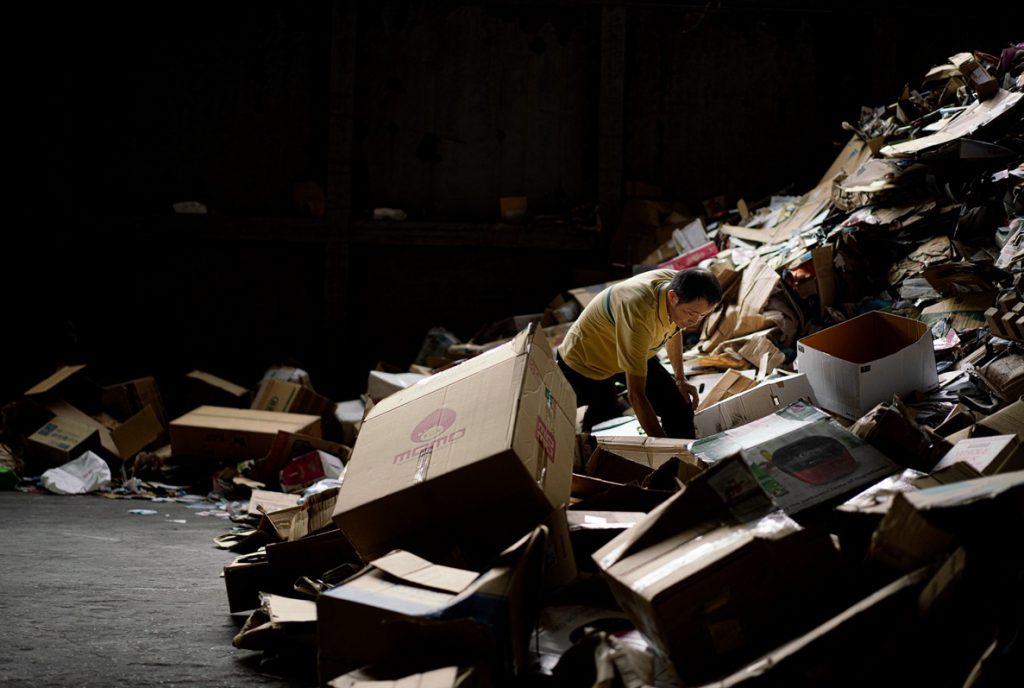The Boon and Bane of Online Shopping
By Weiweoi Chen (陳芛薇)
Photos by Tzu Cheng Liu (劉子正)
Abridged and translated by Chang Yu Ming (張佑民)
The Boon and Bane of Online Shopping
By Weiweoi Chen (陳芛薇)
Photos by Tzu Cheng Liu (劉子正)
Abridged and translated by
Chang Yu Ming (張佑民)

An online seller promoting and displaying a product via live streaming on Shopee.
Online shopping is growing at an incredible speed, and ecommerce sales in Taiwan have doubled to two hundred billion NT dollars (US$68 billion) in just ten years. As stay-home time is elongated due to the COVID-19 pandemic, ecommerce is only to be even more prevalent. One of the online shopping platforms in Taiwan, PChome, recorded total revenue of 20.9 billion NT dollars (US$715 million) in the first half of 2020, which is a 16.33% growth from last year. "When COVID-19 cases in Taiwan shot above a hundred, we sold 2 million packs of tissue paper in just four days," said Tony Huang (黃偉東), director of public relations for buy123.com, another online shopping platform in Taiwan.
Rosa Chang (張筱祺), a senior industry analyst of Institute for Information Industry, predicted that "The pandemic provided an opportunity for those who had never shopped online before to try, and some may be hooked by its convenience."As more and more people shift their shopping online, issues such as carbon footprint and excess packaging began to surface.

As it is cheap and convenient to send and collect packages through convenience stores, the combined shipping volume of 7-Eleven and FamilyMart in Taiwan is around three hundred million packages a year.
Higher or Lower Carbon Footprints?
According to a study done by Massachusetts Institute of Technology, the carbon footprint of an online shopper is almost two times less than a traditional shopper. An article on GreenBiz stated that a typical delivery of online purchases in the U.K. constitutes a 50-mile round with 120 drops, and produces 50 pounds of carbon dioxide. If the shopper drives to the shop himself, a typical round trip would be around 26 miles, generating 24 times more carbon dioxide.

Some online shopping platforms establish their courier service to provide faster deliveries, such as Momo, which even has a team of motorbike couriers.
In terms of storage, the book The Story of Stuff pointed out that online shopping simplified the steps between manufacturing and selling; thus reducing the need for stockpiling, saving energy from lights and air-conditioning of storehouses. To reduce even more carbon footprint, Ford has developed an app that enables bike couriers to do the last mile deliveries for trucks.
There are too many variables to say for sure whether online shopping or traditional shopping is more eco-friendly. However, some choices can definitely help, such as merging different orders into one shipment, not choosing speedy deliveries, cut down on returns, etc.
More Waste
One thing is for sure: the rise in online shopping also increases packaging waste. By 2050, plastic packaging volume in the world is projected to be triple than that of 2000, amounting to even more than the entire plastics industry today. Packing materials such as poly mailers, bubble wraps, air cushions, etc. are all contributing to the rise in plastic use.

Behind the spotlight, the mountain of packaging waste is slowly turning into a huge environmental problem.
"Sending thousands of products to hundreds of shops for people to purchase versus sending them directly to thousands of households, the packaging needed is very different," said Herlin Hsieh (謝和霖), secretary-general of Taiwan Watch Institute and a staunch activist in waste management issues.
According to statistics from Environmental Protection Administration (EPA), online shopping uses a hundred million packagings per year, generating up to 18 thousand tons of waste. Founder and CEO of PackAge+, Ye De-wei (葉德偉), shared that ecommerce trade in Taiwan is growing at a rate of 7% every year. More online shopping means more resources consumed.
Reducing Packaging Waste
Since last year, EPA has issued a three-step approach to tackle the rise in packaging waste, collaborating with online shopping platforms such as PChome, Shopee, Momo, ETMall, buy123.com, etc.
"Ideally, outer packaging should only be 10% bigger than the packaged contents," said Liu. The first step includes regulations on the proportion of packaging in total weight, tape length, etc. Hence, even though there are 2 million more boxes used for ecommerce this year, the total waste generated was lower than last year.

Overpackaging is a very real and very common problem when convenience is favored over resource conservation.
"The second step is to limit printing on cardboard boxes, so they have higher recycling value," said Liu. Major players in the ecommerce market such as PChome and Momo have switched to using uncolored cardboard boxes with smaller prints.
On the surface, cardboard boxes seem to be more eco-friendly than poly mailers. However, if they are both incinerated after only one use, a cardboard box generates more carbon dioxide. "Manufacturing and incinerating a poly mailer creates 1.2 kg of carbon dioxide, a cardboard box creates 1.92 kg," said Ye. According to statistics, Taiwan incinerates around 210 thousand tons of cardboard boxes every year.
"Reusing the boxes is still better than recycling them," said Herlin.
Reusable Packaging
Reusable packaging may be a better option: return the packaging to the supplier so it can be used again.
PackAge+ designed a reusable, padded, and easy-to-clean shipping bag made using recycled PET bottles. Consumers can choose to have their order shipped using this reusable shipping bag, and return the bags at return boxes placed in restaurants, cafes, etc. Each bag is designed to be used more than 50 times. There are already success stories with similar systems in the Netherlands, Germany, and China.

PackAge+ founder, Ye De-wei, aims to reduce packaging waste by replacing disposable packing materials with reusable ones.
Another company, Picupi, is using industrial surplus fabric to make shipping bags for their products, which can then be used as shopping bags afterward.
A reusable shipping box is not as easy. Sing Home Polyfoam Co., Ltd has designed a durable and collapsible box made using EPP, and are waiting for interested clients. It is a little weird that a supplier for packing materials is designing reusable boxes. "We may not incur a loss from this, but we won't make a profit as well, because these boxes can be used for a long time. What brings in money is the disposable packing material. However, this box is better for the environment, so we still have to do it," said Wu Jia-kun (吳家坤), vice president of Sing Home. On a similar note, Taiwan's post office offers discounts on postage when its shipping box is reused.
The third step of EPA's target is for ecommerce platforms to increase the use of reusable packaging to 10% of their total shipments. However, some doubt its feasibility. "Not just we, but the couriers and the consumers need to make changes as well. What if we don't get our boxes back?" said Lin. Tony asked, "People shop online for the convenience, would they really take the trouble to return the packaging?"
To address this issue, PackAge+ has a discount and deposit policy. When consumers return the shipping bag at a partnered shop, they can get a discount from that shop. "We don't really want to use a deposit policy, but it is one way to encourage returns," said Ye. Most Taiwanese collect their deliveries at convenience stores, so if these stores can have return stations, people can unwrap and return the shipping bags on the spot, which will definitely boost return rates.

The daily shipment volume of this ETMall's warehouse in Taoyuan, Taiwan, grew from 30 thousand items to 40 thousand in three years.
The Rise of Ecommerce
"Online shopping is like the Anywhere Door in Doraemon," Tony described. Without restrictions such as business hours and store capacity, shopping online can be as easy as a click of a button. The item can reach your doorstep in just a few hours, and at a discounted price. Privacy can be protected by choosing to pay using a credit card or cash on delivery. A proper return policy can also safeguard against frauds and scams. With so many benefits, Tony said confidently, "For those who have shopped online, it's near impossible for them to ditch it and return to brick and mortar shopping."
Be it reading news articles online, using social media platforms, or watching videos on YouTube, there are advertisements everywhere on the internet. Depending on the user, the advertisements shown to them are different.
"We may not know what our consumers look like, but we understand them the most. A physical store would not know what a customer has browsed, but online, every movement is recorded," said Tony. "Ecommerce has turned from passive to active. Customer used to be the one searching for products, but now, the advertisements follow him even on other apps and platforms."
According to statistics, online shopping takes up around 10% of total expenditure among Taiwanese, but the local ecommerce market is already the 7th largest in the world, showing great potential for growth. As online shopping will only become more prevalent in the future, the government, ecommerce platforms, couriers, and consumers have to all work together to ensure our convenience does not bring about more impacts to the environment.

Even though they are recyclable, Taiwan still incinerates around 210 thousand tons of cardboard boxes every year.
Contact Us | Plan a Visit | Donate
8 Lide Road, Beitou 11259, Taipei, Taiwan
886-2-2898-9999
005741@daaitv.com
©Tzu Chi Culture and Communication Foundation
All rights reserved.
